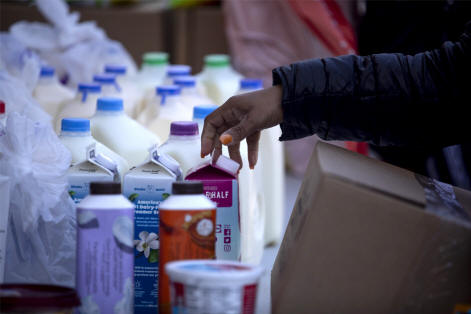|
|
|
|
|
|
 |
|
|
A
federal
worker
moves
through
the food
distribution
line at
an event
giving
food to
federal
workers
affected
by the
shutdown
in
Hyattesville,
Md., on
Oct. 21,
2025.
(Tyrone
Turner/WAMU) |
| |
Shutdown
Standoff
Leave
42
Million
Americans
Without
Food
Assistance
Li Haung
-
National-Politics
Tell Us
USA News
Network
WASHINGTON
- The
United
States
government
shutdown
entered
its 30th
day on
Thursday,
October
30,
2025,
with
food
stamp
benefits
poised
to halt
for
millions
of
Americans
this
weekend
as the
political
impasse
continues.
Government
funding
expired
at
midnight
on
September
30,
2025,
marking
one of
the
longest
federal
shutdowns
in U.S.
history.
The
shutdown
could
become
the
longest
on
record
if it
continues,
surpassing
the
35-day
lapse
that
ended in
January
2019
during
Trump's
first
term.
The
stalemate
centers
on
disagreements
over
healthcare
subsidies
and
government
funding
legislation,
with
both
parties
at an
impasse.
President
Donald
Trump is
calling
on the
Senate
to scrap
the
filibuster
so that
the
Republican
majority
can
bypass
Democrats
and
reopen
the
federal
government.
According
to a
Washington
Post-ABC
News-Ipsos
poll, 45
percent
of U.S.
adults
say
Trump
and the
GOP are
mainly
responsible
for the
shutdown.
The most
pressing
concern
as the
shutdown
continues
is the
Supplemental
Nutrition
Assistance
Program
(SNAP),
which
provides
food
assistance
to
roughly
42
million
Americans,
or about
one in
eight
people
nationwide.
Recipients
receive
an
average
of $187
a month
on a
prepaid
card.
The U.S.
Department
of
Agriculture,
which
oversees
SNAP,
said in
a memo
on
Sunday,
October
27, 2025
that no
benefits
will be
issued
on
November
1.
Agriculture
Secretary
Brooke
Rollins
told CBS
News
that the
Trump
administration
doesn't
have the
legal
authority
to keep
food
assistance
flowing
during
the
government
shutdown,
and it
would
cost
about
$9.2
billion
to fully
fund
SNAP
next
month.
A group
of more
than two
dozen
states
sued the
Trump
administration
on
Tuesday,
October
29,
2025,
seeking
to
maintain
funding
of SNAP
benefits
during
the
ongoing
federal
government
shutdown,
filed
four
days
after
the
Trump
administration
said it
would
not use
$6
billion
in
Congressionally-appropriated
emergency
funding.
Despite
there
being an
emergency
contingency
fund of
roughly
$5
billion,
the USDA
argued
that the
emergency
funding
was not
"legally
available."
This has
drawn
sharp
criticism
from
Democrats,
who
point
out that
similar
emergency
measures
were
used
during
previous
shutdowns.
In a
potentially
significant
development,
a
federal
judge on
Thursday,
October
30, 2025
indicated
she
would
probably
order
the
Trump
administration
to use
reserves
to
partially
fund
food
assistance
for
about 42
million
Americans
in
November,
potentially
delaying
a
complete
cutoff
in
benefits
during
the
government
shutdown.
States
across
the
country
are
scrambling
to
respond
to the
crisis.
Officials
in
Connecticut,
Guam,
Louisiana,
Virginia,
and
Vermont
have
found
ways to
fund the
program
from
anywhere
from a
few days
into
November
to the
whole
month.
California
Gov.
Gavin
Newsom
said he
would
deploy
National
Guard
troops
to
assist
food
bank
operations
and
fast-track
$80
million
to keep
the
state's
food
banks
stocked,
while
New York
Gov.
Kathy
Hochul
is
providing
$30
million
in state
funding
to
support
16
million
meals.
Some
states
are
advising
recipients
to use
their
remaining
food
stamps
wisely,
and food
pantries
are
urging
families
to
prepare
a "plan
B" if
federal
benefits
are
paused.
The
shutdown
continues
to
affect
federal
workers,
air
travel,
and
national
parks.
Hundreds
of
thousands
of
people
are
missing
paychecks
as the
impasse
extends
into
another
week,
and
there
have
been 211
staffing
shortages
reported
in air
traffic
control
since
the
start of
the
shutdown,
more
than
four
times
the
number
reported
on the
same
dates
last
year.
As
Saturday's
November
1, 2025
deadline,
millions
of
vulnerable
Americans
face
uncertainty
about
their
ability
to
afford
food in
the
coming
weeks,
while
political
leaders
remain
deadlocked
over a
path
forward
to
reopen
the
government.
|
|
|
|
|
|
|
|
|